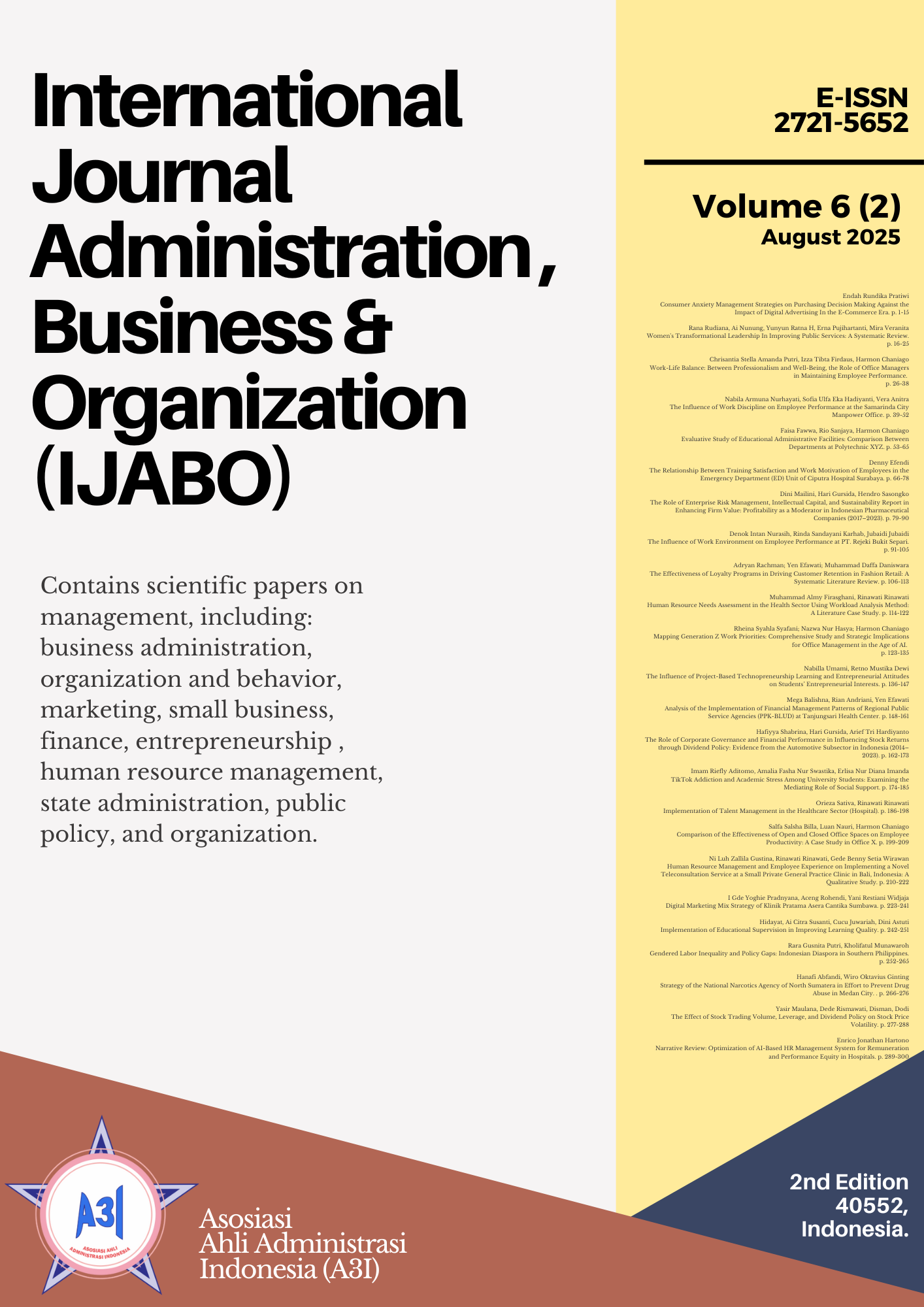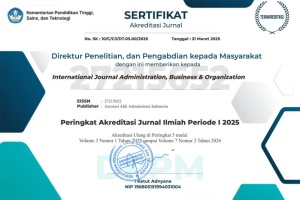The Role of Enterprise Risk Management, Intellectual Capital, and Sustainability Report in Enhancing Firm Value: Profitability as a Moderator in Indonesian Pharmaceutical Companies (2017–2023)
Abstract
This study examines the effect of Enterprise Risk Management, Intellectual Capital, and Sustainability Report on firm value, with profitability measured by Return on Assets as a moderating variable. The research is motivated by the increasing importance of non-financial disclosure in assessing firm value, particularly in high-risk industries such as pharmaceuticals. The objective of this study is to evaluate whether Enterprise Risk Management, Intellectual Capital, and Sustainability Report contribute significantly to firm value and whether profitability enhances this relationship. The research was conducted on pharmaceutical sub-sector companies listed on the Indonesia Stock Exchange during the period 2017 to 2023. This study applied a quantitative approach using panel data regression to analyze direct relationships and moderated regression analysis to assess the moderating effect. The findings indicate that Enterprise Risk Management, Intellectual Capital and Sustainability Report each have a positive and significant impact on firm value. However, none of these variables shows a significant effect on profitability. Furthermore, return on assets demonstrates a positive and significant influence on firm value, but does not moderate the relationship between Enterprise Risk Management, Intellectual Capital, and Sustainability Report with firm value. These results suggest that although non-financial indicators such as enterprise risk management, intellectual capital, and sustainability reporting are critical in enhancing market valuation, they do not automatically translate into short-term financial performance, nor are their impacts conditioned by profitability levels. The study highlights the importance of aligning non-financial strategies with financial performance to ensure long-term value creation.
References
Agung, I. G. N., Anggraini, P., & Surya, R. (2022). Pengaruh intellectual capital terhadap nilai perusahaan: Studi pada perusahaan farmasi. Jurnal Akuntansi dan Keuangan, 13(2), 123–132.
Barney, J. B. (1991). Firm resources and sustained competitive advantage. Journal of Management, 17(1), 99–120. https://doi.org/10.1177/014920639101700108
Brigham, E. F., & Houston, J. F. (2019). Fundamentals of financial management (15th ed.). Cengage Learning.
Chen, M. C., Cheng, S. J., & Hwang, Y. (2005). An empirical investigation of the relationship between intellectual capital and firms’ market value and financial performance. Journal of Intellectual Capital, 6(2), 159–176. https://doi.org/10.1108/14691930510592771
Christophorus, A., Suhardi, S., & Arfan, M. (2023). Sustainability report, GCG, dan kinerja keuangan. Jurnal Riset Manajemen dan Bisnis (JRMB), 8(1), 45–55.
Clarkson, P. M., Li, Y., Richardson, G. D., & Vasvari, F. P. (2011). Does it really pay to be green? Determinants and consequences of proactive environmental strategies. Journal of Accounting and Public Policy, 30(2), 122–144. https://doi.org/10.1016/j.jaccpubpol.2010.09.013
Committee of Sponsoring Organizations of the Treadway Commission. (2020). Enterprise risk management—Integrating with strategy and performance. https://www.coso.org
Deloitte. (2024). Sustainability and climate disclosures: 2024 global report. https://www2.deloitte.com
Desender, K. A. (2007). The relationship between the ownership structure and the role of the board. SSRN Electronic Journal. https://doi.org/10.2139/ssrn.987988
Donaldson, L. (2001). The contingency theory of organizations. Sage Publications.
Eccles, R. G., Ioannou, I., & Serafeim, G. (2014). The impact of a corporate culture of sustainability on corporate behavior and performance. Harvard Business School Working Paper, No. 12-035. https://doi.org/10.2139/ssrn.1964011
Freeman, R. E. (1984). Strategic management: A stakeholder approach. Pitman.
Ghosh, S., & Jain, A. (2014). Firm value, corporate governance, and agency costs: Evidence from India. International Journal of Economics and Finance, 6(6), 116–127. https://doi.org/10.5539/ijef.v6n6p116
Global Reporting Initiative. (2013). G4 sustainability reporting guidelines. https://www.globalreporting.org
Hoyt, R. E., & Liebenberg, A. P. (2011). The value of enterprise risk management. Journal of Risk and Insurance, 78(4), 795–822. https://doi.org/10.1111/j.1539-6975.2011.01413.x
Istiqomah, F., & Rusgowanto, T. (2024). Moderasi ROA pada pengaruh ERM terhadap nilai perusahaan. Jurnal Akuntansi & Keuangan Indonesia, 21(1), 87–99.
Marr, B., Schiuma, G., & Neely, A. (2004). The dynamics of value creation: Mapping your intellectual performance drivers. Journal of Intellectual Capital, 5(2), 312–325. https://doi.org/10.1108/14691930410533722
Mayangsari, R. (2018). Pengaruh struktur modal, keputusan investasi, kepemilikan manajerial, dan komite audit terhadap nilai perusahaan sektor aneka industri yang listing di Bursa Efek Indonesia periode 2012–2016. Jurnal Ilmu Manajemen (JIM), 6(4), 1–10.
Munawwaroh, M., Saputri, N. D., & Santosa, P. W. (2021). ERM dan nilai perusahaan dengan ROA sebagai variabel moderasi. Jurnal Manajemen Indonesia, 15(2), 114–125.
Pagach, D., & Warr, R. (2011). The characteristics of firms that hire chief risk officers. Journal of Risk and Insurance, 78(1), 185–211. https://doi.org/10.1111/j.1539-6975.2010.01378.x
Pulic, A. (1998). Measuring the performance of intellectual potential in knowledge economy. Proceedings of the 2nd McMaster World Congress on Measuring and Managing Intellectual Capital. Hamilton, Canada.
Qudratulloh, A., & Desmiza, R. (2024). The role of profitability in moderating sustainability reporting and firm value. Jurnal Ilmu Ekonomi dan Bisnis Islam, 6(1), 22–34.
Rahmadhanty, A., & Darsono, D. (2020). Intellectual capital dan kinerja keuangan. Jurnal Ilmu & Riset Akuntansi, 9(6), 1–17.
Sakti, R. P., & Desmiza, R. (2024). Intellectual capital, firm value, and the moderating role of profitability. Jurnal Keuangan dan Perbankan, 28(1), 1–12.
Sejati, R. H., & Prastiwi, A. (2015). Sustainability reporting terhadap nilai perusahaan. Jurnal Akuntansi Multiparadigma, 6(3), 428–443.
Siregar, S. V., & Safitri, T. N. (2019). Sustainability report terhadap nilai perusahaan. Dalam Christophorus, A., Suhardi, S., & Arfan, M. (2023). Jurnal Riset Manajemen dan Bisnis (JRMB), 8(1), 45–55.
Spence, M. (1973). Job market signaling. The Quarterly Journal of Economics, 87(3), 355–374. https://doi.org/10.2307/1882010
Stewart, T. A. (1998). Intellectual capital: The new wealth of organizations. Doubleday.
Tjandrakirana, C., & Monika, I. (2014). Pengaruh kepemilikan manajerial terhadap nilai perusahaan dengan kinerja keuangan sebagai variabel intervening. Jurnal Manajemen Bisnis, 11(2), 178–196.
Tobin, J. (1969). A general equilibrium approach to monetary theory. Journal of Money, Credit and Banking, 1(1), 15–29. https://doi.org/10.2307/1991374
World Economic Forum. (2024). Global risks report 2024. https://www.weforum.org/reports/global-risks-report-2024
Copyright (c) 2025 Dini Mailini, Hari Gursida, Hendro Sasongko

This work is licensed under a Creative Commons Attribution-ShareAlike 4.0 International License.
Authors who publish in this journal agree to the following terms:
- The authors confirm that they are the authors of the submitted article, which will be published (online) in the journal IJABO (International Journal Administration, Business & Organization) by the Asosiasi Ahli Administrasi Indonesia (A3i), Bandung, Indonesia. The author’s name will be evident in the article. The publisher makes all decisions regarding the layout and distribution of the work.
- Authors guarantee that the work is their own original creation and does not infringe any statutory or common-law copyright or any proprietary right of any third party. In case of claims by third parties, authors commit themself to defend the interests of the publisher and shall cover any potential costs.
- Authors retain copyright and grant the journal the right of first publication, with the work simultaneously licensed under a Creative Commons Attribution-ShareAlike 4.0 International License (CC BY-SA 4.0). This license allows the redistribution and reuse of papers provided the authorship is properly credited.
- Authors can enter into separate, additional contractual arrangements for the non-exclusive distribution of the journal's published version of the work (e.g., posting it to an institutional repository or publishing it in a book), with an acknowledgment of its initial publication in this journal.
- Authors are permitted and encouraged to post their work online (e.g., in institutional repositories or on their website) prior to and during the submission process, as this can lead to productive exchanges and earlier and greater citations of published work.

















